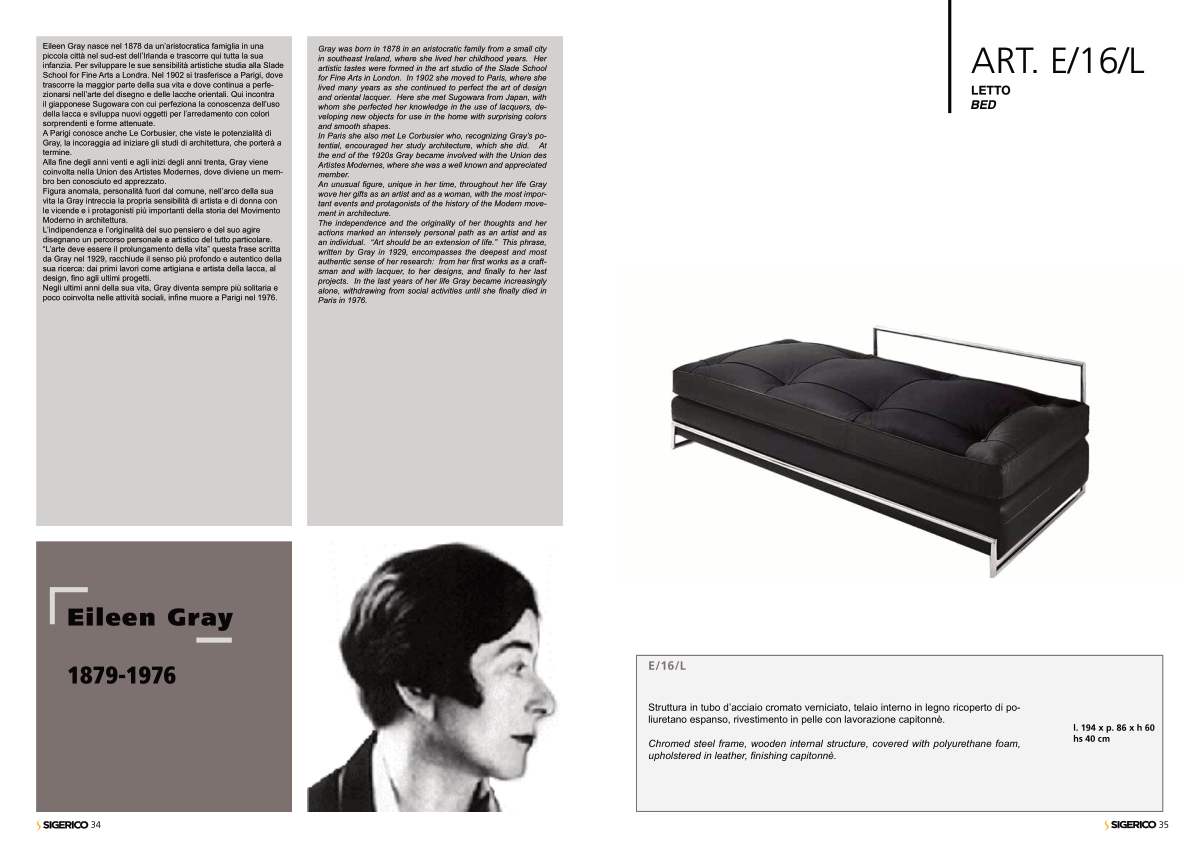Eileen Gray
1879-1976
Eileen Gray nasce nel 1878 da un’aristocratica famiglia in una
piccola città nel sud-est dell’Irlanda e trascorre qui tutta la sua
infanzia. Per sviluppare le sue sensibilità artistiche studia alla Slade
School for Fine Arts a Londra. Nel 1902 si trasferisce a Parigi, dove
trascorre la maggior parte della sua vita e dove continua a perfe-
zionarsi nell’arte del disegno e delle lacche orientali. Qui incontra
il giapponese Sugowara con cui perfeziona la conoscenza dell’uso
della lacca e sviluppa nuovi oggetti per l’arredamento con colori
sorprendenti e forme attenuate.
A Parigi conosce anche Le Corbusier, che viste le potenzialità di
Gray, la incoraggia ad iniziare gli studi di architettura, che porterà a
termine.
Alla fine degli anni venti e agli inizi degli anni trenta, Gray viene
coinvolta nella Union des Artistes Modernes, dove diviene un mem-
bro ben conosciuto ed apprezzato.
Figura anomala, personalità fuori dal comune, nell’arco della sua
vita la Gray intreccia la propria sensibilità di artista e di donna con
le vicende e i protagonisti più importanti della storia del Movimento
Moderno in architettura.
L’indipendenza e l’originalità del suo pensiero e del suo agire
disegnano un percorso personale e artistico del tutto particolare.
“L’arte deve essere il prolungamento della vita” questa frase scritta
da Gray nel 1929, racchiude il senso più profondo e autentico della
sua ricerca: dai primi lavori come artigiana e artista della lacca, al
design, fino agli ultimi progetti.
Negli ultimi anni della sua vita, Gray diventa sempre più solitaria e
poco coinvolta nelle attività sociali, infine muore a Parigi nel 1976.
Gray was born in 1878 in an aristocratic family from a small city
in southeast Ireland, where she lived her childhood years. Her
artistic tastes were formed in the art studio of the Slade School
for Fine Arts in London. In 1902 she moved to Paris, where she
lived many years as she continued to perfect the art of design
and oriental lacquer. Here she met Sugowara from Japan, with
whom she perfected her knowledge in the use of lacquers, de-
veloping new objects for use in the home with surprising colors
and smooth shapes.
In Paris she also met Le Corbusier who, recognizing Gray’s po-
tential, encouraged her study architecture, which she did. At
the end of the 1920s Gray became involved with the Union des
Artistes Modernes, where she was a well known and appreciated
member.
An unusual figure, unique in her time, throughout her life Gray
wove her gifts as an artist and as a woman, with the most impor-
tant events and protagonists of the history of the Modern move-
ment in architecture.
The independence and the originality of her thoughts and her
actions marked an intensely personal path as an artist and as
an individual. “Art should be an extension of life.” This phrase,
written by Gray in 1929, encompasses the deepest and most
authentic sense of her research: from her first works as a craft-
sman and with lacquer, to her designs, and finally to her last
projects. In the last years of her life Gray became increasingly
alone, withdrawing from social activities until she finally died in
Paris in 1976.
ART. E/16/L
LETTO
BED
35
Struttura in tubo d’acciaio cromato verniciato, telaio interno in legno ricoperto di po-
liuretano espanso, rivestimento in pelle con lavorazione capitonnè.
Chromed steel frame, wooden internal structure, covered with polyurethane foam,
upholstered in leather, finishing capitonnè.
l. 194 x p. 86 x h 60
hs 40 cm
34
E/16/L


